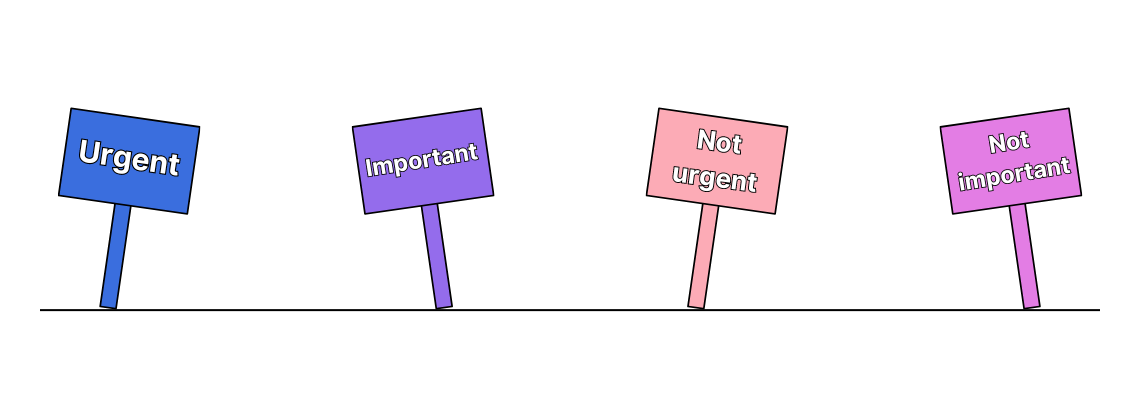
Do you ever feel overwhelmed by an endless list of tasks, unsure of where to start or how to prioritize? You’re not alone. Many of us struggle to focus in today’s fast-paced, information-saturated world, where distractions constantly compete for our attention.
In an era of information overload, mastering prioritization is more crucial than ever. It’s not just about doing more—it’s about doing what truly matters. This is where time management tools come in, offering strategies to boost productivity. Among the many methods available, one simple yet highly effective tool stands out: the Eisenhower Matrix.
Whether you’ve heard of it or not, the Eisenhower Matrix is a powerful prioritization framework that can help you cut through the clutter and focus on tasks that will drive you toward your goals. By breaking tasks down based on urgency and importance, this matrix allows you to organize your time more efficiently, improving both your productivity and peace of mind.
Successful people in any field know the importance of managing their time and tasks effectively. These are essential skills for achieving goals and meeting deadlines. But staying organized and maintaining focus can be challenging. The Eisenhower Matrix offers a clear, actionable solution to help you prioritize and regain control of your workload.
Keep reading to discover how this tool can transform the way you manage your time!
What to expect in this article:
✅ A Deep Dive into the Eisenhower Matrix
✅ Practical Examples and Tips
✅ Actionable Steps for better Time Management
What Is the Eisenhower Matrix?
The Eisenhower Matrix (also known as the Urgent-Important Matrix, Eisenhower Box, Eisenhower Method, and Time Management Matrix) is a decision-making method that helps you sort out tasks based on the criteria of urgency and importance.
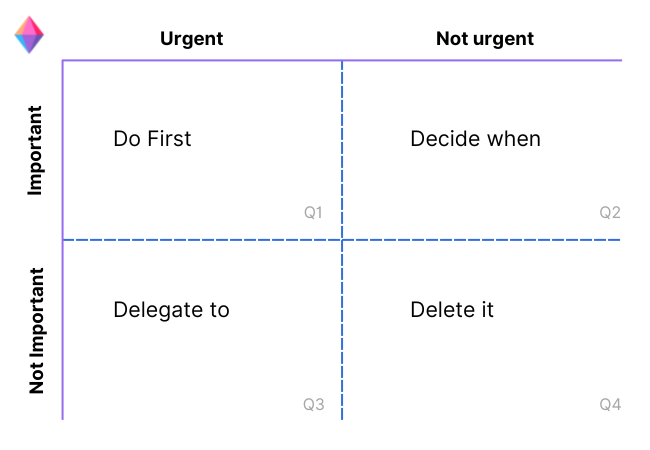
Although simple in its makeup, this prioritization matrix is powerful. Use it to eliminate the noise and time-wasting activities in your life, help you combat the “mere-urgency” effect (more on this later), and increase your mental legroom to make progress on your long-term goals.
This method is particularly useful for people who:
- Find themselves merely running around handling daily crises
- Are busy but feel inefficient and ineffective
- Have long-term goals but no time or energy to make progress on them
- Have trouble delegating tasks or saying ‘no’
With oodles of time management strategies and tools to choose from, what makes the Eisenhower Matrix so noteworthy? It is remarkable because, despite its simplicity, it has outlived the trends (having often been repackaged and sold as new!) and continues to produce results.
The History of the Eisenhower Matrix
For many, the name Eisenhower might sound familiar from U.S. history. The Eisenhower Matrix is indeed named after Dwight D. Eisenhower, the 34th President of the United States. Before his presidency, Eisenhower served as a five-star general and Supreme Commander of the Allied Forces during World War II, where he faced constant tough decisions due to the weight of his responsibilities.
Eisenhower famously said, “I have two kinds of problems, the urgent and the important. The urgent are not important, and the important are never urgent.”
Interestingly, the method gained widespread recognition through Stephen Covey’s best-selling book The 7 Habits of Highly Effective People, where Covey adapted Eisenhower’s decision-making approach into the now well-known Eisenhower Matrix for prioritizing tasks.
How Does It Work? The Eisenhower Matrix Explained
The Eisenhower Matrix is an extremely effective way to prioritize and manage both your time and your tasks. Arranged into four categories, the decision-making method is based on two simple criteria: urgency and importance.
The matrix is systematized with four quadrants, structured according to urgency on the x-axis and by importance on the y-axis. According to priority and urgency levels, the user organizes their tasks and activities into the following categories:
- Quadrant 1: Do first – get it done now
- Quadrant 2: Decide when – make a schedule, set a deadline
- Quadrant 3: Delegate to – divide the workload
- Quadrant 4: Delete it – eliminate unnecessary elements
How to Decipher the Urgent from the Important
To effectively manage your time, mastering the skill of categorizing tasks into four quadrants is essential, though challenging. The key is focusing on tasks that offer the most significant results with the least effort, aligning with the Pareto Principle.
The Pareto Principle states that 80% of results come from 20% of effort. However, many people waste time on less impactful activities, falling into the trap of “present shock“, where immediate demands overshadow long-term priorities. This tendency is linked to the “Mere-Urgency Effect“, where we prioritize tasks with deadlines, regardless of their importance.
It’s crucial to differentiate between urgent and important tasks. Urgent tasks demand immediate attention—like tax deadlines or health issues—while important tasks contribute to long-term goals and values. Brett McKay, founder of the Art of Manliness, emphasizes that clarity on what’s important simplifies decision-making.
Rory Vaden, author of Procrastinate on Purpose, argues that successful people act as “time multipliers,” focusing on actions that create more time in the future. Instead of reacting to emergencies, they prioritize tasks that free up time.
As Youtuber John Green notes, productivity isn’t about becoming a problem-solving machine, but about recognizing the value of time and managing it wisely. By making conscious, purpose-driven choices, you can stop the endless cycle of reactive decision-making and focus on what truly matters.
Start Doing What Matters Using the Eisenhower Matrix
-
Do first – Get it done now: Tasks that are urgent and important
Quadrant 1 tasks are inevitable, and characterized as urgent and important; they require direct and immediate attention. These tasks have a tendency to be more tedious and challenging consequently requiring more time and attention to complete.
Tasks that land in the first quadrant are often the direct result of procrastination. They should, however, be tackled first and completed as soon as possible.
Use Mark Twain’s Eat the Frog principle to master possible task paralysis. The term ‘eat that frog’ refers to getting your worst task out of the way first. Eating the frog implies you finish a task you don’t want to do, but know you have to do. These tasks ultimately give you a strong feeling of accomplishment once completed.
For those of us who work best under pressure or with clear deadlines, you can use the Pomodoro technique to help you focus on the task.
Types of Quadrant 1 Tasks include:
- Review a document for your manager
- Finalize the employee payslips
- Pick up the dry cleaning on Friday afternoon for the weekend event
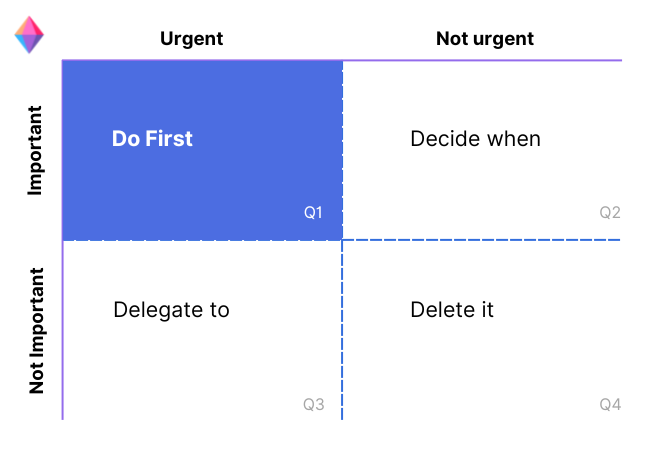
-
Decide when – Make a schedule, and set a deadline: Tasks that are important, but not urgent
Not every important task has to be finished in one day. Tasks that are important, but not urgent are generally long-term projects or assignments that require sufficient planning and a certain amount of time to be executed properly.
Termed the sweet spot of personal time management, the second quadrant is the spot focused on personal improvement in terms of opportunities and growth. Quadrant 2 is the perfect location to write down a list of your meaningful goals. It’s essential to focus on setting clear goals and objectives for tasks in this quadrant.
Types of Quadrant 2 Tasks:
- Set up a marketing budget for the following year
- A restart of your fitness regimen
- Update your will
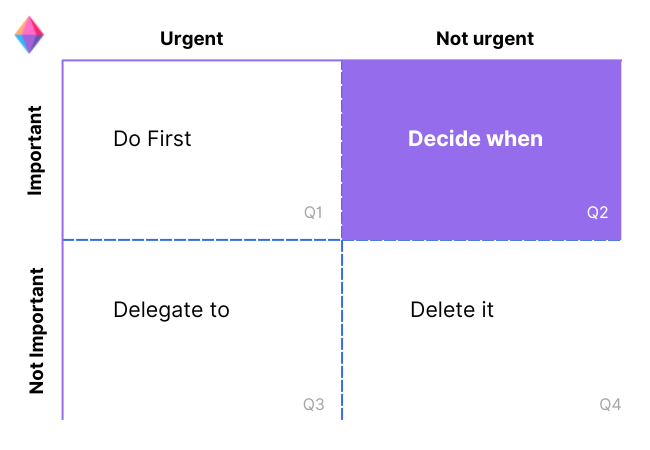
-
Delegate to – Divide the workload: Tasks that are urgent, but not important
Quadrant 3 is where the mere-urgency effect affects lives. Even if you and I were the best multi-taskers and extremely efficient in our jobs, we have to face the fact that we aren’t Superman.
The common phrase, “teamwork makes the dream work” isn’t famous just because it is catchy, but because it is true.
Good leaders and managers know when to do a task themselves and when to delegate the work to someone else. Sometimes it’s best to delegate a task you could do yourself to a co-worker knowing they might be the better person to complete the job. Delegation requires clear workplace communication to ensure tasks are understood and completed efficiently.
Types of Quadrant 3 Tasks:
- Schedule a job interview
- Go food shopping
- Book flights for vacation
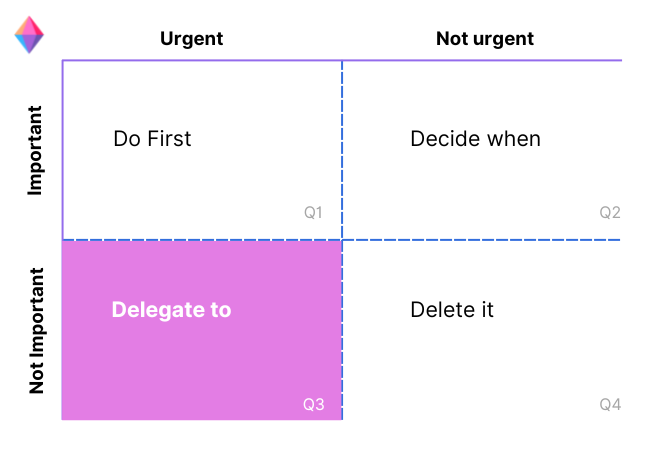
-
Delete it – Eliminate unnecessary elements: Tasks that are neither urgent nor important
Quadrant 4 is the quadrant of excess and immediate gratification. Tasks that are neither urgent nor important are to be placed in the trash, out of sight and out of mind. Depending on the situation, such tasks could reappear on your to-do list in a week’s time but do not need to be done yet and may even be considered a waste of time.
Types of Quadrant 4 Tasks:
- Buy a new coffee machine
- Renew magazine subscription
- Sort through junk mail
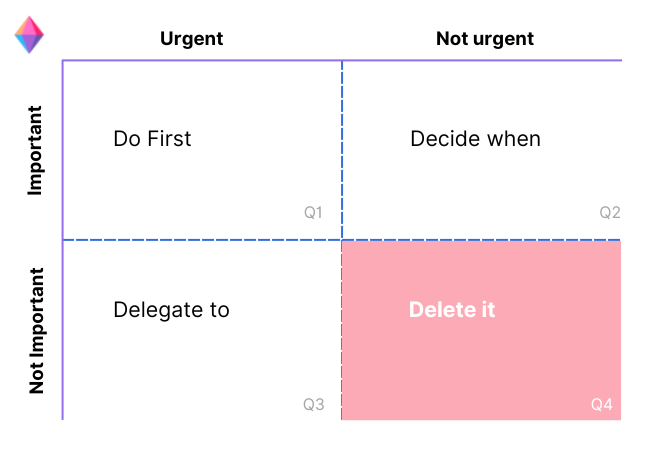
Best Practice Tips for Using the Eisenhower Matrix
Although the Eisenhower Matrix is a simple and straightforward tool, there are several ways to optimize its use for maximum effectiveness. Here are some tips to help you get the most out of it:
- Add a splash of color! Use color-coding to visually differentiate categories and quadrants, allowing for a quick overview of your priorities.
- Separate business from leisure. Maintain distinct lists for professional and personal tasks. This makes it easier to stay organized without the confusion of mixing tasks like scheduling a doctor’s appointment with booking a business trip.
- Make it visual. If the traditional square layout doesn’t suit you, try organizing your matrix Kanban-style. Many tools offer this format, which may feel more intuitive. Here’s a Zenkit template to help you implement the prioritization matrix:
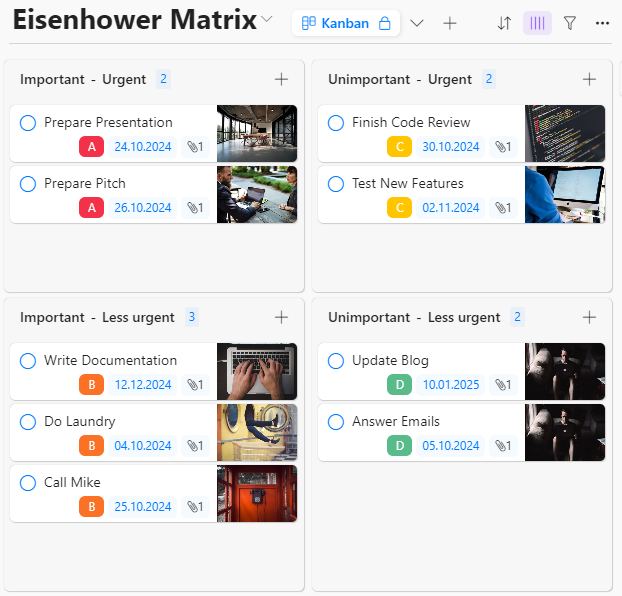
- Label everything. Labels provide an easy way to keep things organized, especially for tasks that might shift between categories over time. In a Kanban layout, labels can help you categorize tasks into the four quadrants.
- Go digital and save paper. Instead of using paper, explore online task management tools to track your progress. These tools, such as Zenkit, are especially helpful when working with teams or managing both personal and professional tasks efficiently.
Convinced That the Eisenhower Matrix Is for You? Here Are Some Things to Consider
Advantages of the time management matrix:
- Cost-effective and accessible: One of the most significant advantages of the Eisenhower Matrix is its simplicity and low cost—it’s completely free! You don’t need expensive software or complicated tools to get started. All you need is paper or a digital tool, making it one of the easiest and most budget-friendly time management methods.
- User-friendly and adaptable: No special training is required to use the Eisenhower Matrix. It’s intuitive, allowing anyone to categorize tasks based on urgency and importance. The absence of rigid rules means you have full control over how to classify your tasks, offering flexibility to personalize the system to suit your unique work style and priorities.
- Improves decision-making skills: Regular use of the matrix sharpens your decision-making abilities. By frequently assessing what’s urgent versus important, you naturally develop the habit of prioritizing tasks more effectively. This can lead to quicker, more confident decisions in all areas of life, from personal tasks to professional responsibilities.
- Encourages regular review and self-awareness: The Eisenhower Matrix promotes regular reflection and self-analysis. As you track your tasks and progress, you gain insights into how well you manage your time. This increased self-awareness can lead to better work habits, help you identify patterns of inefficiency, and foster personal growth over time.
Disadvantages of the Eisenhower Matrix:
- Limited criteria: While the matrix excels at organizing tasks by urgency and importance, it doesn’t account for other crucial factors such as available resources, task complexity, or the level of effort required. If a task requires collaboration or specific tools, the matrix alone (without a project management tool to back it up) may not be sufficient for thorough planning.
- Requires time and discipline: Like any effective tool, the matrix requires consistent effort to be useful. Categorizing tasks daily or weekly can be time-consuming, and without discipline, it’s easy to let this habit slip. However, the value lies in making the Eisenhower Matrix a routine part of your planning, ensuring that task management doesn’t become a chore but a helpful guide to start each day with clear intentions.
- Risk of overwhelm and task paralysis: If not managed carefully, the matrix can lead to overwhelm, especially when too many tasks accumulate. With an overloaded quadrant, you may experience “task paralysis,” making it difficult to move forward. To avoid this, limit the number of tasks per quadrant and focus on high-impact activities. This keeps the matrix manageable and prevents you from feeling buried in your to-do list.
Key Takeaways on the Eisenhower Matrix, Time Management, and the Universe
Staying organized in this time-pressured world can prove challenging due to overlapping commitments and spontaneous ‘urgent’ meetings. A recurring false pretence of urgency can also cloud one’s understanding or definition of an ‘urgent matter’.
A common cause of stress and job burnout is improper time management. Utilizing this method helps you learn key principles of planning, prioritizing, delegating, and scheduling. The Eisenhower Matrix is a simple aid to help you increase productivity and complete tasks that matter.
This prioritization matrix may not work for all, but it’s a great starting point. You can use it as a stepping stone to finding a more personalized, better-suited technique. So, what are you waiting for?
- Set yourself up for success.
- Stop hustling without purpose.
- Switch to prioritizing long-term goals over shallow task wins.
- Start working on what matters.
All the best,
Jessica and the Zenkit Team





Leave a Reply